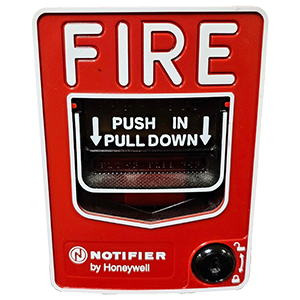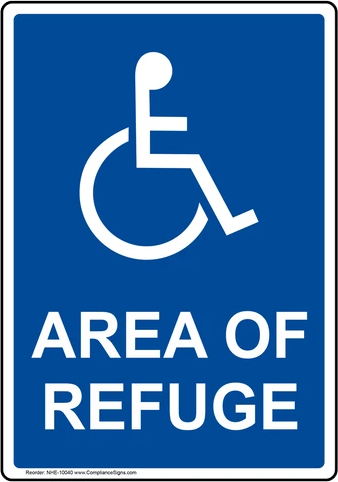Fire Related Emergencies
If You Discover a Fire
Life safety is ALWAYS the highest priority in any type of emergency.
If you discover a fire:
- Activate the building’s fire alarm system to evacuate the occupants
- Attempt to quickly put out the fire by using the appropriate fire extinguisher ONLY if:
- The fire is small in size (the size of a wastebasket) – Never fight a spreading fire;
- You are trained and feel comfortable using the extinguisher; and
- You are able to maintain a clear, unobstructed exit route from the location of the fire.
- If a fire alarm pull station cannot be located, dial 911 to report the fire
- Also report all fires to University Police at 412-268-2323 who can quickly provide assistance while awaiting the arrival of the fire department
The Building’s Fire Alarm System
 Most of the university’s buildings are equipped with fire alarm systems that notify occupants of a fire. When activated, the fire alarm system initiates flashing/strobing warning lights, horns/buzzers, and in some cases, a pre-recorded voice message that provides evacuation instructions. Alarm signals are also transmitted to a 24-hour monitoring station that reports the potential fire to the Pittsburgh Bureau of Fire and the University Police”. “While the fire alarm system can be automatically activated through a smoke or heat detector, a manual means of activation is also provided. Manual fire alarm pull stations can be found in hallways and near exit doors. If you notice a fire, locate the closest pull station and follow the instructions listed on the cover. This is typically achieved by pulling down on a lever located on the bottom half of the pull station.
Most of the university’s buildings are equipped with fire alarm systems that notify occupants of a fire. When activated, the fire alarm system initiates flashing/strobing warning lights, horns/buzzers, and in some cases, a pre-recorded voice message that provides evacuation instructions. Alarm signals are also transmitted to a 24-hour monitoring station that reports the potential fire to the Pittsburgh Bureau of Fire and the University Police”. “While the fire alarm system can be automatically activated through a smoke or heat detector, a manual means of activation is also provided. Manual fire alarm pull stations can be found in hallways and near exit doors. If you notice a fire, locate the closest pull station and follow the instructions listed on the cover. This is typically achieved by pulling down on a lever located on the bottom half of the pull station.
Never hesitate to activate the building's fire alarm system.
Basic Evacuation Instructions
While on campus, you may need to evacuate from an Academic, Administration or Housing building at any given moment regardless of the time of day or weather condition. Listed are key points to a safe and timely building evacuation.
- If you hear the fire alarm or are instructed to evacuate, remember ALL occupants must evacuate the building. NEVER ignore the alarm.
- Shut off any heat sources or equipment that you may be using, quickly gather your personal belongings (keys, purse, bag) and proceed to the nearest exit in an orderly fashion, but do not run.
- Help those who may require assistance.
- CMUSafe Ambassadors may be present to provide directions to the nearest exit.
- For more information on the CMUSafe Ambassadors Program: https://www.cmu.edu/drbc/em/cmusafe-ambassador.html
- When leaving a room or corridor, close the doors as you leave. Never prop open or disable fire doors.
- It is best to know and practice at least two ways out of the building.
- Once you exit the building, report to your building's designated assembly area. If you are unfamiliar with this area, move to a safe location away from the building. This will allow others to evacuate unobstructed from the building and provide clear access to responding emergency personnel.
- In times of inclement weather, seek shelter in other near-by, unaffected facilities, but do not block the exits inside the other buildings.
- Once evacuated from the building do not re-enter until given the all clear to return inside by emergency responders, CMUSafe Ambassadors or authorized personnel. Just because the alarm is silenced or you no longer hear a sounding alarm it does not mean that it is safe to re-enter the building.
Need for Assistance

Carnegie Mellon University is committed to providing a safe environment for all. While disclosing a disability is not required, those who choose to self-identify can request to have accommodations made to assist in evacuating a building during a fire emergency. It is best to have arrangements pre-planned for evacuation assistance. Those arrangements can be made to reasonably assure that assistance is provided to anyone who requests it. For individuals with disabilities or that may need assistance during an emergency, we encourage employees to contact HR-Disability Services and students to contact the Office of Disability Resources to request support or additional accommodations. For other questions, contact DR/BC.
In the event of a fire emergency where you cannot self-evacuate:
- Shelter in Place (SIP) until you can be rescued by an emergency responder
- Most of the enclosed stairwells on campus are constructed of fire-resistant materials and can be used as an area of refuge.
- Call Campus Police directly at 412-268-2323, through the Rave Guardian mobile app or 911 if off campus and report your location and request assistance. If available, utilize an Emergency Communication Device such as an Emergency Phone or Code Blue Emergency Help Station to contact University Police.
- Tell others evacuating the facility to inform emergency responders of your location and that you are in need of assistance.
- You can also ask someone exiting the building to notify the emergency responders (Police or Fire) or a CMUSafe Ambassador outside the building of your location and need for assistance.
- It is recommended to carry with you a cell phone, whistle, and a flashlight to help signal or make noise to get attention for help.
Fire Extinguisher Use
Some basic knowledge regarding the safe and appropriate use of fire extinguishers is essential. Fire extinguishers are designed to fight only small fires (the size of a wastebasket) and must be used correctly. Remember to never fight a spreading fire. No attempts should be made to extinguish any fire physically larger than you.
ENSURE THE FIRE ALARM SYSTEM IS ACTIVATED BEFORE YOU ATTEMPT TO EXTINGUISH A FIRE AND EVACUATE THE BUILDING WHEN EXTINGUISHING EFFORTS ARE NOT EFFECTIVE.
Fire extinguishers are designed to be easily operated by those who are properly trained and when used properly can quickly extinguish small fires safely.
The technique to remember for using a fire extinguisher is P.A.S.S.
PULL the pin. Pull out the locking pin that prevents the extinguisher from accidently discharging. Twist the pin as you pull to help break the plastic seal that holds the pin in place.
AIM the extinguisher nozzle at the base of the fire.
SQUEEZE the handle grips to release the extinguishing agent.
SWEEP the extinguisher slowly and evenly across the BASE of the fire. Continue to apply the extinguishing agent until the fire is out or the extinguisher empties.
Extinguisher Precautions
- Life safety is more important than fighting a fire. When in doubt, EVACUATE!
- Before using an extinguisher, make sure you have the right type of extinguisher to extinguish the fire. Using the wrong extinguisher can make the situation worse (e.g., using a water extinguisher on an electrical or grease fire).
- Ensure that the fire does not cut off your exit path.
- NEVER turn your back to the fire, even if you believe it to be completely extinguished.
- You must still activate the fire alarm and evacuate the building, closing doors behind you.
- Report all fires by activating the building’s fire alarm, and calling 911. Extinguished or not, you must also report all fire incidents by calling University Police at (412)-268- 2323.
For additional questions or concerns please contact EHS: safety@andrew.cmu.edu